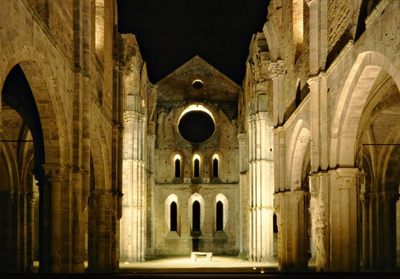The Cistercian Abbey of San Galgano is an historically and architecturally one of the most important religious monuments in Siena countryside and, together with the nearby chapel at Monte Siepi, is an important expression of the gothic Cistercian style in Italy.
The Cistercian order was born in Citeaux, Bordeaux, in 1098 as a means of reinforcing the Benedictine order and restoring the discipline which had progressively been lost. Cistercian monasteries were built throughout Europe, primarily along important arteries and roads leading to Citeaux. Construction began on the abbey of San Galgano in 1218 in the vicinity of Chiusdino and Monticiano on the Massetana road and just a short distance from the Merse river.
Architecturally, its severe, rigorously formal design was intended to exemplify the moral rigour upheld by St. Bernard. Not coincidentally, the abbey was built in an area already sanctified by the presence of the chapel at Monte Siepi, built at the end of the twelfth century to consecrate the home of the young hermit Galgano Guidotti, who died in 1181 and was canonized in 1185.
The abbey was consecrated seventy years after the first stone was laid. This marked the onset of frenetic religious activity and of activity in general in an area where the valley is wide-open and sunny. First the marshy fields were drained, and then the river’s flow was harnessed to produce hydraulic energy.
It seems that the original design of the abbey foresaw mills for flour-making and wool processing. But in the end the abbey enjoyed only a brief life. Decline was brought on first by famine in 1329 and then by Bubonic plague in 1348, sealing the fate of this monastic settlement.
In the sixteenth century the structure itself began to succumb, especially once the lead roofing was sold.
Categories: About TuscanyTuscany things to do

0 Comments